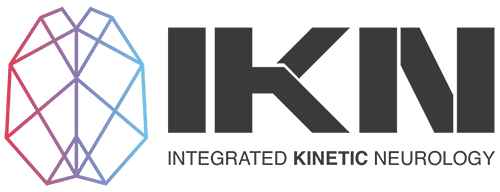
Level 1 & 2: What’s The Difference?
Our Approach
Our IKN Approach Level 1 & 2 courses are organized around giving you the tools to navigate the assessment and rehab of musculoskeletal conditions from a neuromechanical perspective.
Each course is jam-packed with theory, manual & active assessments, and exercises that are guided by a unique progression & regression framework. You will come away not only with new assessments & treatment strategies, but with a step by step framework to guide the implementation of those strategies.
There are three key components of our course material:

- Neuromechanical features
- These are features of our movement system that help it manage & distribute forces & loads. These are neurological, muscular, and joint features that we all possess and can integrate with other unique individual findings to create a well-rounded rehab plan. These can be used to guide our assessment and to support our rehab/loading strategies.
- Current variability measures
- We use a unique framework to guide how we assess muscular & joint/segmental variability. This gives us an insight into the current scope of movement options that an individual has access to, which helps us determine what capacities may need to be addressed throughout the rehab process.
- Unique individual factors
- Every individual has a unique experience, with unique factors related to their main problem/concern. For example, two unique individuals with low back pain may have different aggravating/easing factors, a different injury/pain history, different tolerance/sensitivity levels, different past treatment approaches, different movement habits, and so on. These unique features will massively influence how we organize the rehab process for them. We need to integrate these unique individual factors, neuromechanical features and their current variability measures to facilitate a comprehensive plan.
Level 1 key features
Both our online & in-person Level 1 courses are split into 8 parts:
- Understanding neuromechanical features
- Our muscular & joint variability framework
- Lower limb assessment
- Lower limb rehabilitation
- Upper limb assessment
- Upper limb rehabilitation
- Midline assessment & rehabilitation
- Visual, vestibular, and TMJ assessment & rehabilitation
Level 1 integrates “neuromechanical features” and “current variability measures” to help guide the assessment & rehabilitation of these key body regions (lower limb, upper limb, and midline).
In this course, focus is placed on giving you the tools to assess the muscular & joint variability of these key body regions, and use our progression/regression framework to guide the implementation of exercises based on those assessment findings.
At the end of each part, we work through case studies (8 case studies total in level 1) to help you integrate this material into real-world scenarios.
Level 2 key features
Both our online & in-person Level 2 courses are also split into 8 parts, and as you can see below, we go much deeper into local body region assessments & rehabilitation:
- Low back & hip assessment and rehabilitation
- Knee assessment and rehabilitation
- Foot & ankle assessment and rehabilitation
- Neck & thoracic spine assessment and rehabilitation
- Shoulder assessment and rehabilitation
- Elbow & wrist assessment and rehabilitation
- Lower limb plyometric progression framework
- Upper limb plyometric progression framework
Yes, that is a lot to cover in one course! But, it builds on the foundation set in Level 1 that allows us to go much deeper into the muscular and joint interactions of local body regions, and integrates the “unique individual factors” component of our approach.
Each part is guided by 1-2 comprehensive case studies (14 case studies in total within level 2), where we cover the assessment & rehabilitation of specific musculoskeletal conditions, and outline the entire session flow (clinical reasoning, exercises used, progressions/regressions, problem-solving etc).
We find using case studies to guide our assessment & rehabilitation strategies to be a much richer learning experience for our participants, instead of simply going through the assessments & rehab strategies with little context.
An example of how our knee assessment & rehab is organized within level 2:
- Knee biomechanics: femoral, patellar, and tibial interactions
- Case study: anterior knee pain
- Subjective & objective assessment
- Establishing an entry point to rehab
- Entire session flow with clinical reasoning
- Other local & global exercise/rehab options
- Case study: medial knee pain
- Subjective & objective assessment
- Establishing an entry point to rehab
- Entire session flow with clinical reasoning
- Other local & global exercise/rehab options
- Other sagittal, transverse, and frontal plane loading options
Each case study gives our participants a better understanding of how they can use the assessment findings to guide the implementation of rehab/exercises, but most importantly, how we can coordinate this with the “unique individual factors.”
Using case studies, we can navigate some of the challenges we may experience when working with people experiencing pain and/or movement limitations:
“What if you utilize an exercise but the client tells you they have pain during?”
“What if this client with current knee pain had an ACL reconstruction 3 years ago that wasn’t rehabbed properly?”
“What if you determine that a client’s knee pain is being influenced by an old ankle injury that wasn’t rehabbed properly?”
These are some of the questions that we work through and the processes that we navigate, because it ultimately gives our participants a clearer understanding of how they can integrate this material in the real world.
After level 1 & level 2, participants can then join our private group where we can continue to discuss assessments, rehab strategies, case studies and much more!
These courses are jam-packed with a huge amount of material to help you build a comprehensive assessment & rehabilitation approach to tackle musculoskeletal conditions. If you want to learn more, make sure you pre-register for Level 1 & 2 that go on sale during black friday! Don’t miss out!
